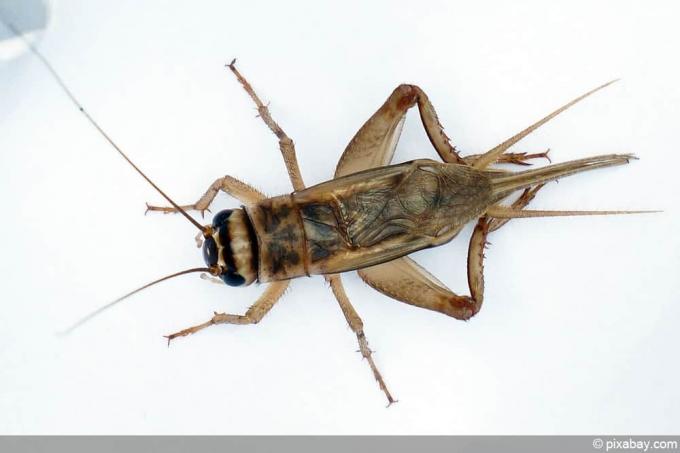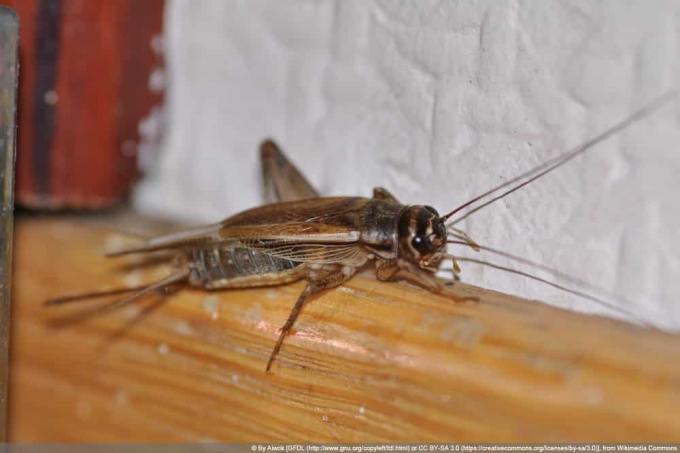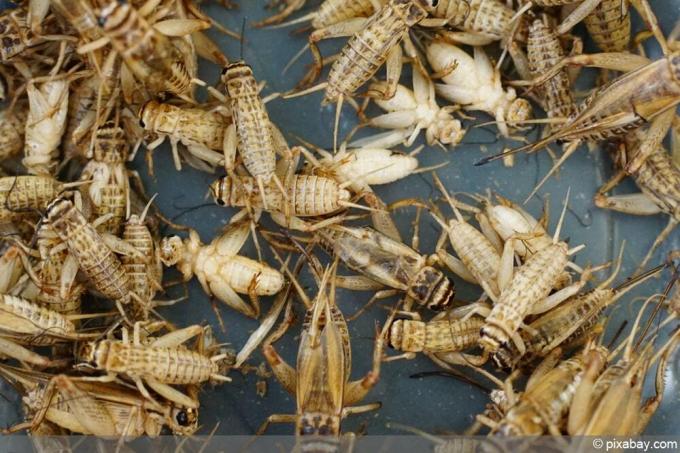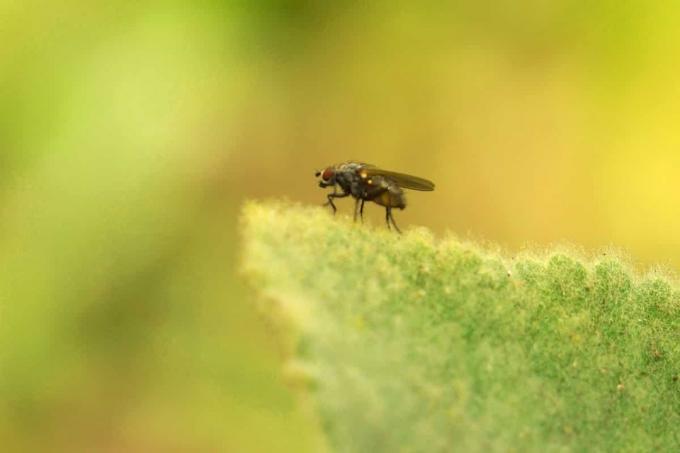

Table of contents
- What do crickets look like?
- Eliminate breeding sites with a vacuum cleaner and hot water
- Set up cricket bait
- Make sticky traps yourself
- Vinegar and pepper as a repellent
- Water lily juice and milk – homemade natural insecticide
- Tips for Prevention
Nobody wants to share their apartment with crickets. The nocturnal chirping of the male house crickets robs us of our well-deserved sleep and the females lay up to 2600 eggs, which can result in an annoying plague. As if that wasn't bad enough, the omnivores are devouring our food. In order to get rid of the house crickets, you can still save yourself the use of chemical insecticides. This guide is equipped with 5 home remedies for crickets. This is how you fight the pests in harmony with nature.
What do crickets look like?
House crickets belong to the cricket family and are related to grasshoppers. The botanical name Acheta domesticus refers to two outstanding attributes of this insect species. Acheta means 'singer' and domesticus means 'domestic'. The nocturnal song comes from male crickets and can reach nerve-wracking frequencies of up to 3,800 hertz. House crickets are inevitable because they cannot survive the winter in the wild. The insects are widespread in Central Europe because they have sufficient living space as human descendants. House crickets prefer to stay in warm places with sufficient food and water nearby, such as boiler rooms, pantries, greenhouses, rubbish bins; but also in summer compost heaps. You can identify house crickets at a glance by these characteristics:
- Body color: straw yellow to yellowish brown
- Length: 16 to 20 mm (females add 11 to 15 mm for the rod-shaped ovipositor on the rump)
- Wings: Forewings noticeably shorter than hindwings
- Special feature: clearly thickened hind legs and two long antennae on the head
While house crickets are capable of flight, they rarely use their wings for this purpose. In order to move quickly, the powerful hind legs are used for short, high jumps.
Eliminate breeding sites with a vacuum cleaner and hot water
Crickets live an average of 10 weeks. During this time, the females lay between 1,100 and 2,600 eggs after being mated by the singing males. Preferred breeding places are moist soil, organic kitchen waste or sawdust. If house crickets have given themselves away by their chirping song, you should primarily look for possible breeding grounds, because from here a plague of crickets can spread in the house. Carefully inspect the apartment for eggs and larvae. House cricket eggs are 0.3 x 2.3 mm long, whitish and curved. The larvae are from 2.5 mm long and grey-black. How to get rid of the brood:
- Vacuum up eggs and larvae
- Seal the filter in a plastic bag and dispose of with household waste
- Thoroughly clean all breeding sites with hot water
If possible, use hot water to control the brood, since the eggs in particular are not sensitive to room temperature humidity.
Set up cricket bait

After you have prevented a plague of crickets in the apartment with a vacuum cleaner and hot water, the adult house crickets come into focus. Since the insects are active at dusk and at night, visual contact is rare. One of the tried-and-tested home remedies for combating this is cricket bait, which does not contain any toxic additives. Rather, the craving for sweets becomes the undoing of the winged nuisances. How to do it:
- Mix sugar cane molasses with hot water in a ratio of 1: 4
- Let cool and pour into small, shallow bowls
- Set up at all suspected infestation spots in the house
House crickets can't resist the sweet temptation, hop into the molasses and drown.
Make sticky traps yourself
Sticky traps are a tried and tested means of ecological pest control. Since there are no toxic ingredients here, troubled homeowners like to use this method to get rid of house crickets. You can purchase sticky traps ready-made or simply make them yourself. Thats how it works:
- Attach double-sided tape in front of the nooks
- Brush lightly with honey or molasses
If a house cricket has fallen victim to the sticky trap, please replace the adhesive tape as soon as possible so that carcasses do not warn other members of the same species.
Tip:
If there is repeated infestation with house crickets in an apartment building, the origin of the plague is often in the apartment of a terrarium keeper. House crickets are fed to various terrarium animals as live food and use the ventilation slots of the terrarium to escape.
Vinegar and pepper as a repellent
Are you reluctant to sentence harmless crickets to death? Then make the environment in the apartment as uncomfortable as possible for house crickets so that they voluntarily clear the field. The ingredients for the deterrent are on every kitchen shelf. This is how the plan works:
- Provide a barrier to all potential food sources in the home
- Brush vinegar all over and sprinkle with hot pepper
- Refresh this moving barrier every 2 to 3 days
The combination of vinegar and pepper acts as an impassable barrier for house crickets. Sooner or later the insects will have to look around for new food sources and flee.
Water lily juice and milk – homemade natural insecticide

The mountain farms, alpine pastures and farms in the Alps have always been haunted by house crickets, which find their way from the alpine meadows into the house. In search of effective home remedies against the plague spirits, we found what we were looking for in an Austrian business book from 1847. Here is a chapter dedicated to vermin control and describes an effective recipe against crickets in the home. The main ingredient is the juice of yellow water lilies (Nuphar lutea). The alkaloids it contains are toxic to humans and animals. The highest level of toxins is found in the fleshy rhizomes. A little milk is added to fool the clever house crickets about the toxic ingredient. How to make the home remedy yourself:
- Put on gloves
- Crush and squeeze the rhizome of the water lily
- Alternatively, chop and squeeze the leaves
- Collect the plant juice and mix it with fresh milk (no UHT milk) in a ratio of 2:1
Add a drop of honey or molasses for better adhesion and increased curling effect. Spread the household remedy with a brush on all known and suspected infested areas. The attracted crickets absorb the poisonous substance and die.
Tip:
In the encyclopedia of household affairs from 1828 one can read about a method of combating hard-boiled people: in the evening throw fresh leaves and twigs of elderberry onto a really glowing coal fire; this results in a powerful vapor that draws into every crevice. Most of the house crickets are dead the next morning; other house crickets sit languidly on the walls, so that one can grasp them.
Tips for Prevention
Once crickets romp around in the apartment, the nocturnal insects are difficult to locate and even more difficult to get rid of. So that you don't have to deal with the rowdies in the first place, we recommend the following measures for effective prevention:
- Check windows and doors for holes in order to seal them with silicone
- Seal cracks in walls with putty
- Close waste bins in the kitchen and in front of the house with lids
- Draw the curtains first in the evening and at night when windows are opened
- The evening seating area on the balcony is illuminated with subdued special lamps against insects
In summer gardens, crickets prefer to nest in warm, humid places. When the temperatures drop in autumn, the insects find their way into the house from here to spend the winter safely and warmly. Put a stop to this hustle and bustle by mowing the lawn regularly, thinning out and cutting back shrubs and bushes. Woodpiles or the compost heap should be located as far away from the house as possible. Clean rain gutters regularly from leaves, because house crickets prefer to lay their eggs in these places.
 garden editorial
garden editorial I write about everything that interests me in my garden.
Learn more about home pests

Drive away cockroaches: leave the light on at night?
Cockroaches are among the most disgusting pests that can appear in living spaces. But the disgust factor is only one side of the coin. The other is that the crawlies contaminate food supplies with pathogens. It is therefore essential to declare war on insects. Can cockroaches be repelled by leaving the light on at night?

Spotting mites in bed: 9 signs of bed mites
Mites are found everywhere in the home. Even in a clean, well-groomed bed, millions of animals can be found. This is not only a problem for allergy sufferers, but can also cause allergies.

Identify cockroaches: what do cockroaches look like?
Cockroaches are disgusting, everyone agrees on that. Worse still, they nibble at our food supplies and leave behind disease-causing germs. Because cockroaches flee and hide at lightning speed, we rarely see them. But then everyone should recognize them immediately.

Electric spider in the house: how to get rid of it
A thin body and long, thin legs characterize the electric spider. It got its name because it trembles when touched. The insect likes to stay indoors. Read how to banish the unwanted guest from your apartment.

Caution hantavirus: properly remove mouse droppings
Anyone who lives in the country, maybe keeps animals or who is often out and about in the forest is at risk from so-called hantaviruses. These are transmitted by mice and their droppings, so you should take extra precautions when removing them.

Fight houseflies: 10 remedies & tips
The housefly can be fought with various traps that have been prepared with attractants. Adhesive surfaces or liquids ensure that the insects can no longer escape. In addition, there are simple measures to keep the annoying flies out of the apartment.

